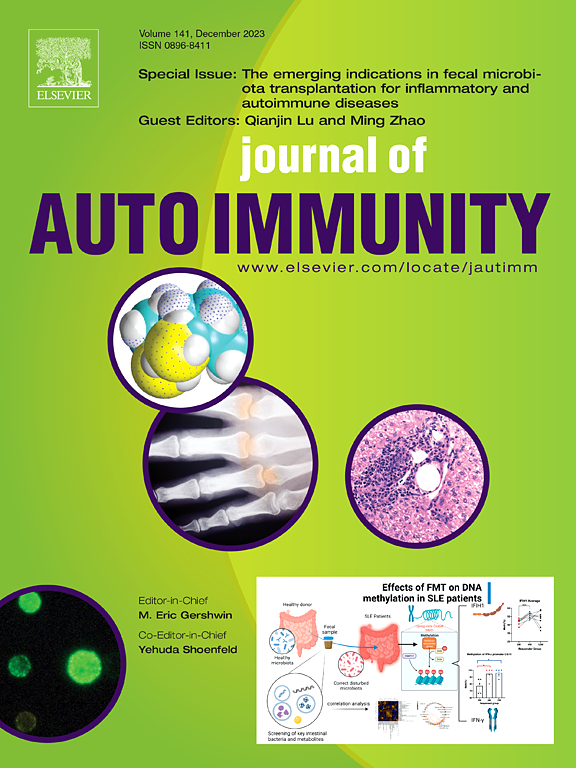钙保护蛋白和神经丝血清水平与强化治疗下重症肌无力治疗反应相关的初步研究
IF 7
1区 医学
Q1 IMMUNOLOGY
引用次数: 0
摘要
目的针对高活性、乙酰胆碱受体抗体阳性(AChR-Ab+)的全身性重症肌无力(gMG)患者,最近出现了新的治疗选择,包括速效终板保护剂,如补体C5抑制剂(C5- i)和新生儿Fc受体抑制剂(FcRn-I)。然而,除了临床评分系统之外,缺乏客观的生物标志物来指导个性化的治疗决策。方法在这项探索性的、前瞻性的现实世界研究中,我们评估了22例AChR-Ab+ gMG患者的血清钙保护蛋白(sCLP)和血清神经丝轻链(sNfL)水平,这些患者的C5-I或FcRn-I均为treatment-naïve。生物标志物水平的变化与临床反应相关,通过重症肌无力-日常生活活动(MG-ADL)评分来衡量。结果我们观察到sCLP和sNfl的变化与C5-I和FcRn-I治疗的临床治疗反应相关。具体来说,根据MG-ADL评分,sNfL和sCLP水平升高与治疗反应不良相关。结论我们的初步研究结果表明,全身性炎症(如sCLP)和局部神经肌肉连接处破坏(如sNfL)的标志物可能有助于gMG患者的治疗决策。需要更大规模的多中心研究来验证这些结果并确定其临床应用。本文章由计算机程序翻译,如有差异,请以英文原文为准。

Calprotectin and neurofilament serum levels correlate with treatment response in myasthenia gravis under intensified therapy–A pilot study
Objective
New therapeutic options have recently emerged for patients with highly active, acetylcholine receptor antibody–positive (AChR-Ab+) generalized myasthenia gravis (gMG), including fast-acting, endplate-protective agents such as complement C5 inhibitors (C5-I) and neonatal Fc receptor inhibitors (FcRn-I). However, objective biomarkers beyond clinical scoring systems are lacking to guide individualized treatment decisions.
Methods
In this exploratory, prospective real-world study, we assessed serum calprotectin (sCLP) and serum neurofilament light chain (sNfL) levels in a total of 22 AChR-Ab+ gMG patients, who were treatment-naïve for either C5-I or FcRn-I. Changes in biomarker levels were correlated with clinical response, as measured by the Myasthenia Gravis–Activities of Daily Living (MG-ADL) score.
Results
We observed a correlation of changes in sCLP and sNfl with clinical treatment response to C5-I and FcRn-I therapies. Specifically, rising levels of sNfL and sCLP were associated with a poor treatment response, as measured by the MG-ADL score.
Conclusion
Our preliminary findings suggest that markers of systemic inflammation (such as sCLP) and local destruction of the neuromuscular junction (such as sNfL) may assist in treatment decision-making for gMG patients. Larger, multicenter studies are warranted to validate these results and define their clinical utility.
求助全文
通过发布文献求助,成功后即可免费获取论文全文。
去求助
来源期刊

Journal of autoimmunity
医学-免疫学
CiteScore
27.90
自引率
1.60%
发文量
117
审稿时长
17 days
期刊介绍:
The Journal of Autoimmunity serves as the primary publication for research on various facets of autoimmunity. These include topics such as the mechanism of self-recognition, regulation of autoimmune responses, experimental autoimmune diseases, diagnostic tests for autoantibodies, as well as the epidemiology, pathophysiology, and treatment of autoimmune diseases. While the journal covers a wide range of subjects, it emphasizes papers exploring the genetic, molecular biology, and cellular aspects of the field.
The Journal of Translational Autoimmunity, on the other hand, is a subsidiary journal of the Journal of Autoimmunity. It focuses specifically on translating scientific discoveries in autoimmunity into clinical applications and practical solutions. By highlighting research that bridges the gap between basic science and clinical practice, the Journal of Translational Autoimmunity aims to advance the understanding and treatment of autoimmune diseases.
 求助内容:
求助内容: 应助结果提醒方式:
应助结果提醒方式:


